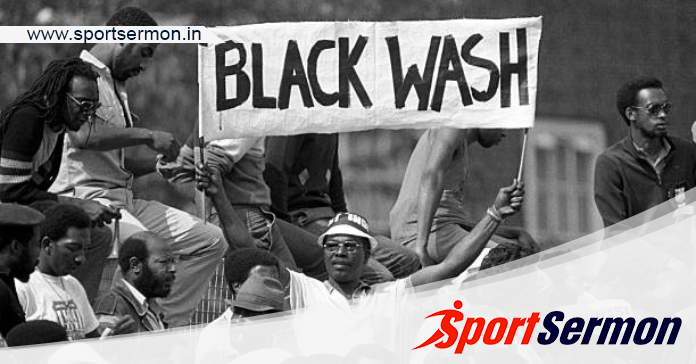The West Indies tour of England in 1984 was a highly anticipated cricket series that took place from May to August 1984. This tour marked the 26th time that the West Indies cricket team visited England for a Test series. The West Indies team, led by Clive Lloyd, was known for its dominance in world cricket during this era.
The build-up to the tour was filled with excitement and anticipation as both teams were considered strong contenders. The West Indies team had established themselves as the world’s best team, having won the previous two editions of the Cricket World Cup in 1975 and 1979. They were also the reigning champions of Test cricket, having defeated England in a series in the Caribbean in 1981.
England, on the other hand, had been going through a period of rebuilding their team after a series of disappointing performances. They were determined to regain their status as one of the top teams in international cricket and saw the upcoming series against the West Indies as an opportunity to prove themselves.
The West Indies team arrived in England with a formidable lineup that included some of the greatest cricketers of all time. Their batting lineup boasted players like Gordon Greenidge, Desmond Haynes, Vivian Richards, and Clive Lloyd himself. These players were known for their aggressive and attacking style of play, which often put opposition bowlers under immense pressure.
In addition to their strong batting lineup, the West Indies also had a fearsome pace bowling attack. The likes of Malcolm Marshall, Joel Garner, Michael Holding, and Andy Roberts formed a formidable quartet that struck fear into the hearts of batsmen around the world. Their ability to generate pace and movement made them a lethal force on any pitch.
England, under the captaincy of David Gower, had a talented but relatively inexperienced team. They had some promising young players like Ian Botham, David Gower himself, Allan Lamb, and Derek Pringle. However, they were up against a West Indies team that was at the peak of its powers and had a wealth of experience.
The series consisted of five Test matches played at various venues across England. The first Test took place at Trent Bridge in Nottingham, followed by matches at Lord’s in London, Old Trafford in Manchester, Headingley in Leeds, and The Oval in London.
West Indies Dominated England Throughout the 1984 Test Series
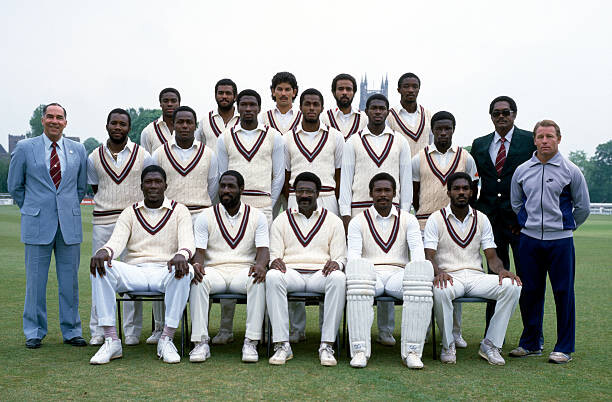
England vs West Indies First Test Match
England took on West Indies after winning the toss and opting to bat first. Early in the game, a significant incident occurred as debutant opening batsman Andy Lloyd was struck on the head by a short-pitched delivery bowled by Malcolm Marshall. This unfortunate event led to Lloyd’s departure from the field and an extended hospital stay, ultimately preventing him from participating in cricket for the rest of 1984 and eliminating any future Test Match appearances for him.
Facing adversity at 89-5, England managed to salvage their innings with a resilient knock from Ian Botham, who contributed 64 runs. This effort enabled England to accumulate a total of 191 runs, though not without Joel Garner’s impactful performance of 4-53 with the ball.
West Indies, in response, dominated the match by amassing a substantial score of 606 runs. A significant portion of their runs came from multiple players reaching half-centuries, including Larry Gomes (143) and Viv Richards (117).
The duo’s third-wicket partnership of 206 runs stood out. Richards, in addition to his individual feat, became the fourth West Indian batsman to cross the milestone of 5,000 runs in Test matches. The West Indies captain, Clive Lloyd, also contributed with a solid score of 71.
Even the lower-order batsmen of West Indies made remarkable contributions, exemplified by Eldine Baptiste (87*) and Michael Holding (69) sharing a 9th-wicket partnership worth 150 runs. Despite this notable display of batting prowess, Derek Pringle’s bowling effort managed to yield some success, with his figures of 5-108.
England’s struggles continued in their attempt to save the match, with wicketkeeper Paul Downton stepping up as a makeshift opening batsman in the absence of the injured Andy Lloyd. Downton’s efforts resulted in a score of 56, yet England could not withstand West Indies’ dominance. The match concluded on the fourth day with Joel Garner once again proving pivotal, taking another five-wicket haul, this time with figures of 5-55.
The significance of West Indies’ triumph in this match extended beyond the game itself. This victory marked the beginning of a remarkable 5-0 series sweep known as the “blackwash,” where West Indies secured victories in all five Tests, establishing their dominance over England with resounding margins.
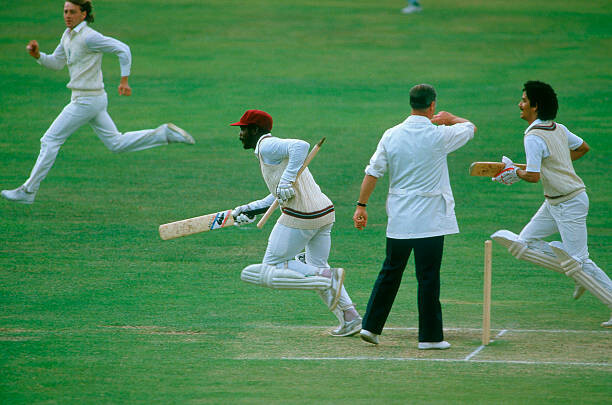
England vs West Indies Second Test Match 1984
West Indies won the toss and elected to field first against England. However, their decision appeared misguided as England’s opening batsmen, Graeme Fowler and debutant Chris Broad, stitched together a century opening stand. This partnership propelled England to a total of 286 runs in their first innings.
Fowler led the charge with an impressive knock of 106, while Broad marked his debut with a solid contribution of 55 runs. Notably, extras were third on the scoring list, tallying up to 35 runs. West Indies’ Malcolm Marshall posed a significant challenge with the ball, capturing 6 wickets for 85 runs.
England managed to secure a first-innings lead as they bowled out West Indies for 245 runs. Ian Botham’s remarkable performance saw him claim 8 wickets for 103 runs, a historic feat as the first Englishman to achieve such figures against West Indies on English soil. West Indies’ Clive Lloyd posted a modest score of 39, becoming the second West Indian batsman to surpass the milestone of 7,000 Test runs.
England’s second innings witnessed sterling batting displays from Allan Lamb and Ian Botham. Lamb’s brilliant knock of 110 and Botham’s strong contribution of 81 propelled England to a total of 300 for 9, prompting them to declare their innings open at the commencement of the fifth day.
In a breathtaking pursuit of 342 runs to claim victory, West Indies executed the chase with remarkable ease. They achieved their target in just 66.1 overs while losing only one wicket along the way. The standout performers in this triumphant run chase were Gordon Greenidge, who remained unbeaten with a commanding 214 runs, and Larry Gomes, who provided unwavering support with an unbeaten 92 runs. The pair’s unbroken partnership of 287 runs formed the backbone of West Indies’ victory, sealing their success in a splendid manner.
England vs West Indies Third Test Match 1984
In the third match, England won the toss and chose to bat first for the third consecutive Test match. Allan Lamb’s resilient performance saw him reaching a well-earned century as England’s innings came to a close at 270 runs. Michael Holding, displaying his skill with the ball, secured figures of 4-70 for West Indies. In doing so, he became the second West Indian cricketer to amass 200 Test wickets.
West Indies responded by securing a slight first-innings advantage, reaching a total of 302 runs. Larry Gomes stood out with an unbeaten century, scoring 104*, while Holding contributed notably once again, this time with a score of 59. Paul Allott’s bowling prowess was on display as he claimed 6 wickets for 61 runs.
As the match progressed, England’s second innings ended on a disappointing note, with the team being dismissed for a mere 159 runs. Malcolm Marshall delivered a standout performance with the ball, capturing 7 wickets for 53 runs, marking his best career bowling analysis up to that point, despite having sustained a broken thumb in two places during the match.
In their pursuit of victory, West Indies managed to chase down their target with 8 wickets in hand. Their triumph was marked by a collective effort from their team. Amidst this, batsman Paul Terry made his debut appearance for England in the Test match, although his contributions were limited to scores of 8 and 1.
The significance of this match extended beyond the field as well. It marked the conclusion of the Test career of Bob Willis, who played his final Test match during this encounter.
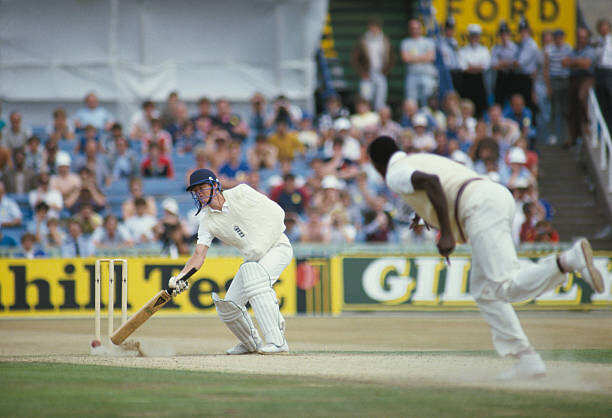
England vs West Indies Fourth Test Match 1984
West Indies made a strategic decision by winning the toss and opting to bat first for the first time in the series. The two-day play culminated with West Indies achieving a total of 500 runs, being eventually all out. The notable performances included Gordon Greenidge securing his second double century of the series, a remarkable 223 runs, and wicketkeeper Jeff Dujon contributing a century with 101 runs.
England’s veteran off-spinner, Pat Pocock, made a noteworthy comeback for the match and managed to record England’s best bowling figures, taking 4 wickets for 121 runs. England’s response was marred by an unfortunate incident involving their number 3 batsman, Paul Terry.
During his innings, he was struck by a ball bowled by Winston Davis, resulting in a broken arm and his subsequent departure from the field. England’s ninth wicket fell at a total of 278 runs, leaving them needing just 23 runs to avoid the follow-on. In a remarkable display of determination, Terry returned to the field with his arm in a plaster cast and supported by a sling.
He watched Allan Lamb achieve his century, but was unable to defend his wicket against Joel Garner, who claimed his fourth wicket by bowling Terry for a scoreless end to his innings. England reached a total of 280 runs, with Lamb once again leading the batting efforts by remaining unbeaten on 100*, marking his third consecutive Test century. Extras followed as the second-highest contributor with 44 runs.
As a consequence of their performance, England found themselves following on in their second innings. Their batting struggle continued as they were bowled out for 156 runs. Roger Harper’s off-spin prowess was evident as he claimed an impressive 6 wickets for 57 runs. Unfortunately, Paul Terry did not get another opportunity to bat for England after his injury.
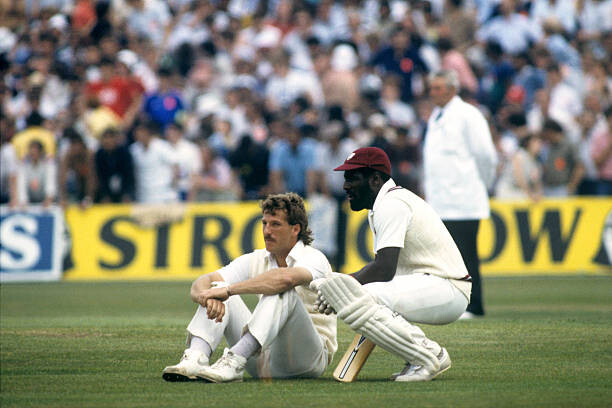
England vs West Indies Fifth Test Match 1984
In the concluding Test match of the series, West Indies maintained their winning streak by winning the toss and once again opting to bat. The English bowling unit saw the debut of Jonathan Agnew and Richard Ellison. Surprisingly, England’s bowlers found rare success by dismantling West Indies’ top order, reducing them to a precarious 70-6.
However, Clive Lloyd’s resilient innings of 60* managed to bring West Indies to a more respectable total of 190 runs all out by the close of the first day. Ian Botham stood out with a stellar bowling performance, securing 5 wickets for 72 runs. This remarkable feat made Botham the first cricketer to achieve the “triple double” milestone of 300 wickets and 3,000 runs in Test matches.
England’s batting lineup, unfortunately, failed to capitalize on the progress made by their bowlers. They were bowled out for just 162 runs, with only Graeme Fowler managing to score more than 20 runs.
Malcolm Marshall’s impressive bowling performance saw him claim 5 wickets for 35 runs. In West Indies’ second innings, they piled on the runs, reaching a total of 346 runs, with Desmond Haynes showcasing his batting prowess with a century, scoring 125 runs.
With a target of 375 runs to win, England struggled and eventually collapsed for 202 runs all out. Ian Botham emerged as the top scorer for England with 54 runs. The West Indian bowling duo of Joel Garner (4-51) and Michael Holding (5-43) wreaked havoc, capturing a total of 9 wickets between them.
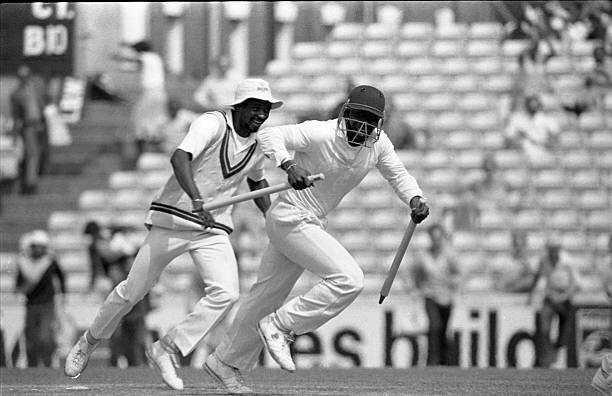
With this victory, West Indies achieved a historic milestone by securing the fifth 5-0 whitewash in Test cricket history. Moreover, this tour marked the first and, to this day, only instance of a touring side accomplishing a five-test whitewash.
The West Indies team was in its prime during this period, winning eight consecutive tests and setting a then-record of 11 consecutive wins. This series is widely acknowledged as the zenith of West Indies’ dominance, solidifying their position as the preeminent test side for the remainder of the decade.
The West Indies dominated the series from the start, winning the first three Tests convincingly. They showcased their batting prowess with big centuries from Gordon Greenidge, Vivian Richards, and Clive Lloyd. Their pace bowlers wreaked havoc on the English batsmen, consistently taking wickets and putting pressure on the home team.
The West Indies tour of England in 1984 showcased their dominance in world cricket during that era. They displayed their batting firepower and bowling prowess to outclass England in every aspect of the game. The series highlighted the immense talent and skill possessed by the West Indies team and solidified their status as one of the greatest cricket teams of all time.

